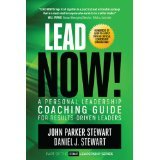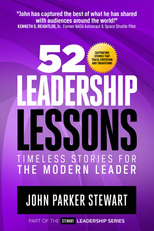LEAD NOW!: A Personal Leadership Coaching Guide for Results-Driven Leaders
Leadership Excellence, $26.95, 244 pages
Can’t Put Them Down!
John Parker Stewart is an internationally recognized leadership coach with 35 years of experience in executive development, team performance and leadership coaching. Mr. Stewart created a leadership tool named LEAD NOW! Leadership Development Model. This book is co-authored with his son Daniel J. Stewart, who is an organizational development consultant and coach. The model was created to provide a simple and comprehensive framework for leaders to use as they lead their teams. This book dissects and explains Stewart’s 21 Dimensions of leadership. There are six chapters which include; How to use LEAD NOW!, the LEAD NOW! Model, 21 Leadership Dimensions, Assessments, Leadership Exercises and Action Planning. The four main components to the model are four perspectives for leaders: their people, their business, their marketplace and their organization. The four quadrants are color coded for easy recognition. It also contains note pages where the reader can write down ideas as he reads.
 The book begins with a self-assessment for the four quadrants and then breaks down the dimensions listed under each quadrant. There is also a self-assessment for each dimension. As is typical with Stewart’s books, there is a place for reflection and specific questions to ponder. The book then explains each dimension such as; effective communication, problem solving or time management and offers tips for each criterion. Each dimension also includes references, a self-assessment, action planning notes and several questions to answer. Chapter Five covers five leadership exercises which help a leader with additional tools for the various situations he might face as he leads his team. Chapter Six is all about action plans and includes an example of a completed action plan, as well as, blank action plans for the reader to complete.
The book begins with a self-assessment for the four quadrants and then breaks down the dimensions listed under each quadrant. There is also a self-assessment for each dimension. As is typical with Stewart’s books, there is a place for reflection and specific questions to ponder. The book then explains each dimension such as; effective communication, problem solving or time management and offers tips for each criterion. Each dimension also includes references, a self-assessment, action planning notes and several questions to answer. Chapter Five covers five leadership exercises which help a leader with additional tools for the various situations he might face as he leads his team. Chapter Six is all about action plans and includes an example of a completed action plan, as well as, blank action plans for the reader to complete.
LEAD NOW! is not a book to be read quickly, but instead a book to be viewed like a conversation with a mentor or personal coach. This book demands reflection and thoughtful introspection but will reward the reader with a wealth of knowledge, insight and growth that typically takes years to develop. Keep this book close to you, visit it often and give it the time and reflection it deserves, if you truly want to develop your leadership skills.
 52 Leadership Gems supports the LEAD NOW! tool. This book is practical and insightful. I found myself nodding and smiling a lot as I was reading the gems. When Mr. Stewart wanted to make a key point during a training or coaching session, he did so with a “gem” or core message. Often his learners would write them down, share them and even post them at their desks. Some of the gems are Stewart’s creation but most came from a variety of sources. They serve as an effective, daily reminder for key leadership ideas.
52 Leadership Gems supports the LEAD NOW! tool. This book is practical and insightful. I found myself nodding and smiling a lot as I was reading the gems. When Mr. Stewart wanted to make a key point during a training or coaching session, he did so with a “gem” or core message. Often his learners would write them down, share them and even post them at their desks. Some of the gems are Stewart’s creation but most came from a variety of sources. They serve as an effective, daily reminder for key leadership ideas.
Each gem in the book is presented within a colorful box and is tied to leadership dimensions of Stewart’s LEAD NOW! model. Since the model’s dimensions are color-coded, they are also brilliantly color-coded back to the gem. Following this information is an overview and explanation of the gem. The next two sections are what really make this book an effective tool: application and reflection. For example, Gem #39 reads, “Change is bad until it succeeds.” This gem ties to the leadership dimensions of customer focus, focusing on results, change management, innovation, inspiring commitment and organizational savvy. Following that is an overview of how people often resist change. In the application section, Stewart offers three successful techniques when implementing change. Finally, in the reflection section, Stewart lists five questions to reflect upon as a leader is working through change with his or her team. The index ties each gem to the 21 leadership dimensions so it is very easy to find gems based on the topic one wants to address.
The beauty of this book is its simplicity in thought and organization. New leaders, as well as tenured ones, will find a practical, useful tool as they manage their teams successfully. Leaders will refer to this book often for the perfect quote, an insightful question or just to be inspired themselves.
This third book in the LEAD NOW! Model series is organized by 52 leadership lessons with catchy names such as; Baboons and Impalas, Two Friends and a Giant, A Spider in Space and The Farmer and the Rock, to name a few. The titles will peak your interest, the stories will keep you engaged. Many of the stories read similar to an Aesop’s Fable. Each lesson is in a highlighted, colored box and is followed by the corresponding leadership dimensions (color-coded once again). A story trails with an explanation. The final section to each lesson is the application.
The application sets this book apart from most leadership books because often leadership books extol a methodology but never really engage the reader to actually try to apply the concept. This book does. Finally, the section ends with another highlighted, colored box with a summary statement that makes the lesson memorable.
For example, Lesson #3 states, “Employees are like Turtles”. This lesson aligns with the leadership dimensions of delegating, focusing on results, coaching, team building and inspiring a commitment. A story follows which reminds the reader that a turtle, when scared, shrinks back into its shell for safety. In other words, if an employee is afraid of making a mistake, she will hide in her shell and never really meet her full potential. Productivity and morale suffer as a consequence. Following the story, there are four questions in the application section and the lesson ends with a key point, “Give your employees the opportunity to stick their necks out without getting ‘whacked’”.
Leaders will be inspired, regardless of the experience level or tenure. The lessons are simple and straight forward but also logical and practical. If more leaders reached for Stewart’s book, I can only imagine what teams could accomplish!
Reviewed by Seniye Groff
Interview with John Parker Stewart 
1. What is the most creative use of a gem that you have seen?
I worked with a team of senior executives in Hong Kong that integrated the GEMS into their everyday conversation. Each week, they incorporated and emphasized one GEM into daily decisions and problem solving. The GEMS integrated in their minds to such a degree that a team member would merely call out the GEM number and the entire team knew to exactly what they were referring. The GEMS became an integral part of their culture and vernacular, and this team personified Gem #48: “Culture is defined and re-defined every day.”
2. What are the most valuable skills needed of a leader, in your opinion?
The most valuable skill a leader can develop is the ability to gain and maintain the trust of those they lead. If nobody trusts you, then they will not really care what you say, do, or implement. I am not just talking about the general trust that you are a decent human being (e.g., you will not steal from them or stab them in the back), although that is a start; the trust to which I refer is a deep inner-core trust that people can genuinely rely on. Gem #41 reinforces this premise: “You can buy hands and feet, but you must earn the heart.” When you have earned their heart, you not only get their best efforts from their hands and feet, but you also gain their full commitment.
3. How did you come up with some of the titles in the 52 Leadership Lessons book?
Titles were a fun part of the development process. I hoped that the titles would ignite a spark of interest in the stories to both entice the reader to want to read more, and retain the valuable lessons of an aspect of leadership. Titles, such as “Chains and Ribbons,” “Lobsters and Egos,” and “Blinded by an Egg,” highlight unconventional pairings of subjects within the story, while other titles highlight a question, such as “Can You See It?” or “Only One Winner?” Each presents a unique situation that leaves a lasting impression on the readers, which will help them recall and apply the lesson when needed.
4. What inspired you to develop the “Lead Now! Model”?
The subject of leadership has been a buzz word in personal development for so long that it may cause one to get a glazed look when it is mentioned. We have tried to change that! The dual nature of this leadership development model helps with both a “Big-Picture” top-down approach, and a “Detail-focus” on the individual components. I have been teaching many of these principles for over 35 years, and have found this model is the best way to help conceptualize leadership—the specific dimensions and attributes and how they relate. This model breaks down the broad umbrella concept of leadership into more concrete and specific attributes that provide a clear path toward improving one’s leadership skills.
5. How do you know the “Lead Now! Model” works?
I know the model works because of the results it has consistently achieved. I have seen managers, executives, and leaders in most every field transform their styles, increase performance, and adapt effectively to significant obstacles by adhering to the specific attributes and dimensions in the model. I continue to see it work in the lives of leaders everywhere—military, sports, industry, politics and education. I have their testimonials and feedback. Furthermore, in addition to the qualitative data, I also have over 25 years of collected data from tens of thousands of leadership assessments on the various leadership dimensions that substantiated the “Lead Now! Model”.
6. Who inspired you as a leader?
I have been inspired as a leader by a variety of prominent individuals throughout history across the arts, military, sciences, religion, government and business. Individuals with whom I work also continually inspire me. These include astronauts, executives, project managers, coaches, educators, scoutmasters, religious leaders and many others. There is no one perfect way to be a leader, so I frequently learn from a variety of observable adaptations of leadership to meet the many individual needs and situations I face. Gem #16 reminds me to “Beware the ‘#1 Syndrome’” and continue to learn from others.
7. What was the greatest lesson you learned as a leader?
Gem #11 summarizes the greatest lesson I have learned as a leader, “When you’re green you grow. When you’re ripe you rot.” I feel the biggest hindrance to building leadership capability is the assumption that one already has sufficient skills. Consequently, I am always keeping an eye out for teaching moments to learn from—whether I am on a hike, watching a movie, listening to a presentation, or weeding the garden—there are always lessons and gems from which to learn. Here is a tip: You know you have internalized the “Lead Now! Model” when you find yourself regularly having teachable moments and you act on them.
8. Besides reading your books, what advice do you offer for a newly promoted leader?
One of the biggest dangers a newly promoted leader can encounter is the assumption that one needs to fix or change too much too fast. We need to be leery of the “clean house” or “steamroller” approach because rarely is it necessary or successful. Take the time to build trust, carefully assess the situation from varied perspectives, and then make decisions. Gem #38 reminds us that “Just because you are good with a hammer gives you no right to view the world as a bunch of nails.” What may have worked for you before may not always be the right approach. Seek input from others, ask for feedback, learn the organization’s history, and then implement specific change. Seeking input from others and asking for feedback are very effective team building tools that a newly promoted leader should always use!
9. Aside from your own work, what is your favorite leadership book?
I have to say the proverbial “Book of Life”—containing the experiences, observations, and people that surround me. These are the stories that I “read” and analyze. I especially enjoy observing and studying how people view their experiences. I find the advice in Gem #6: “27 years of genuine growth or 1 year repeated 27 times?” is particularly relevant. I do not want to just experience the same year repeatedly—I want to experience compounded learning. The goal of the “Lead Now! Model” is not to produce leadership robots who perform the same sequence of events, but to teach principles that help individuals obtain a mindset of learning and application—a mindset of continuous development. Leadership is an on-going journey of learning, testing, observing and applying.
10. What are some of the greatest changes in leadership skills that you have recently noticed in your 35-year career?
The biggest challenge facing today’s leaders is the appropriate use of the tremendously rapid advances in technology. These bring obvious benefits in productivity, efficiency, and communication, but there are also dangers. Gem #29 reminds us: “Every transaction begins with a relationship.” Remember that behind every strategy, spreadsheet, chart or presentation is a person or team. We should heed the counsel of Gem #37: “A desk is a dangerous place from which to view the world.” Do not forget the essential value of face-time. I cannot emphasize enough the value of healthy relationships in all aspects of our lives!
11. Who was your mentor as you were developing your leadership skills?
I think I mirror the experiences of many who have mentored me throughout my career. I cannot single out one in particular; however, I have had several bosses, professors, clients and colleagues who have provided mentoring in a variety of ways. Over the years, I have developed trusted professional relationships with individuals with whom I converse, gain their opinions, insights, and trust their advice. Just as Gem #7 teaches us, I often ask the “Four magic words: ‘What do you think?’” It is my most valuable tool because it enables me to see their perspectives and get outside of myself.


